人教高中英语必修4Unit2动词-ing形式作主语和宾语
- 格式:ppt
- 大小:1.22 MB
- 文档页数:28

V-ing形式作主语和宾语一、V-ing形式作主语1. V-ing形式作主语表示比较抽象的一般行为,尤其是强调多次性的动作。
如:Reading poems gives me much pleasure. 读诗给我带来很多欢乐。
动词不定式作主语常表示具体的某一次动作,特别是将来的动作。
如:To go to town this afternoon is necessary. 今天下午进城是必要的。
2. V-ing形式常用于It’s no use (useless) doing, It’s no good doing, There is no doing (不可能,不允许)句型中。
如:It’s no use forcing children to learn. 强迫孩子学习是没有用的。
There is no telling what will happen. 未来的事,无法预料。
考例:Eugene’s never willing to alter any of his opinions. It’s no use with him.A. to argueB. arguingC. arguedD. having argued答案:B。
3. V-ing形式作主语,谓语动词用单数。
如:Learning new words is very useful to us. 对我们来说学习生词很重要。
二、V-ing形式作宾语1. 跟V-ing形式作宾语的动词有:spend, advise, allow, appreciate, avoid, consider (考虑), delay, enjoy, escape, excuse, finish, keep, imagine, mind, miss, permit, practise, risk, suggest 等及feel like, be fond of, what (how) about等固定词组。

Unit 2Working the landLearning about Language动词-ing形式作主语和宾语【语法感知】①Since then, finding ways to grow more rice has been his life goal.②As a young man, he saw the great need for increasing the rice output.③Y uan Longping searched for a way to increase rice harvests without expanding the area of the fields.④However, he doesn’t care about being famous.⑤He enjoys listening to violin music, playing mah-jong, swimming and reading.⑥Spending money on himself or leading a comfortable life also means very little to him.⑦Just dreaming for things, however, costs nothing.⑧He awoke from his dream with the hope of producing a kind of rice that could feed more people.观察上面句子,思考黑体部分所作的成分:以上动名词短语(加黑部分)在句中作主语的是①⑥⑦;作动词宾语的是⑤;作介词(短语)宾语的是②③④⑧。
【语法精讲】动词-ing形式是动词的一种非谓语形式。
动词-ing形式的时态和语态:动词-ing形式在句中的语法作用:在句中作主语、宾语、表语、定语、状语和宾语补足语。
一、动词-ing形式作主语1.动词-ing形式作主语动词-ing形式作主语时,多表示经常性、习惯性的动作,谓语动词多用单数形式。

动词-ing形式(短语)作主语和宾语一、动词-ing形式(短语)作主语1. 动词-ing形式(短语)作主语,表示比较抽象或泛指的动作。
如:Telling a lie got him into a great deal of trouble.Surfing is a popular sport along coastal areas.2. 动词-ing形式(短语)作主语时,为了保持句子平衡,可以用it 作形式主语。
如:It is no use complaining —it doesn’t he lp solve the problems.In my opinion, it is simply a waste of time and money raising pets.二、动词-ing形式(短语)作宾语1. 作动词宾语。
有些动词后常跟动词-ing形式(短语)作宾语,这类动词常见的有admit, allow, appreciate, avoid, enjoy, consider, dislike, mind, miss, finish, keep, imagine, risk, practise, suggest等。
如:We are considering flying to Paris for the coming holiday.It seems that he doesn’t mind working late into the night.2. 作介词宾语。
介词后可接动词-ing形式(短语)作宾语。
如:She entered without knocking at the door.My sister is busy in reading picture books.注意:1. 有些动词后接动词-ing形式(短语)和动词不定式(短语)作宾语意义不同,如:remember to do sth. 记住要做某事remember doing sth.记得曾经做过某事regret to do sth. 遗憾(抱歉)要做某事regret doing sth. 为做过某事而感到后悔try to do sth. 努力去做某事try doing sth.试着做某事mean to do sth. 打算做某事mean doing sth.意味着做某事want to do sth. 想要做某事want doing sth. 需要被做某事(用动词-ing形式的主动形式表被动意义)2. 在动词-ing形式(短语)前面可以加上其逻辑主语来强调动作的执行者,该逻辑主语常为形容词性物主代词或名词所有格。

动词-ing形式作主语【归纳】★动词-ing形式作主语,表示一般或抽象的多次性动作,谓语动词用单数。
如:Reading aloud is very important for us to learn a foreign language.Going to bed early and getting up early is considered to be a good habit.★动词-ing形式常用于“It is / was +名词/形容词... +动词-ing形式”句型中。
其中,常用此句型的名词有no use, no good, fun等;形容词有useless, nice, good, interesting等。
如:It's no use asking me what I don't know.It was useless speaking.动词-ing形式作宾语【归纳】★有些动词(短语)后只能跟动词-ing形式作宾语,而不能跟动词不定式作宾语。
常见的有:enjoy, admit, imagine, finish, advise, allow, permit, escape, avoid, appreciate, suggest, keep, practise, consider, mind, give up, look forward to, put off, get used to, insist on等。
如:I want to travel because I enjoy meeting people and seeing new places.Dana admitted feeling hurt by what I had said.She imagined herself sitting in her favourite armchair back home.Have you finished reading that magazine?Why don't you give up smoking?We're so much looking forward to meeting you.★有些动词后既可跟动词-ing形式作宾语,也可跟动词不定式作宾语, 且后接以上两种形式作宾语时意义上没有什么区别。
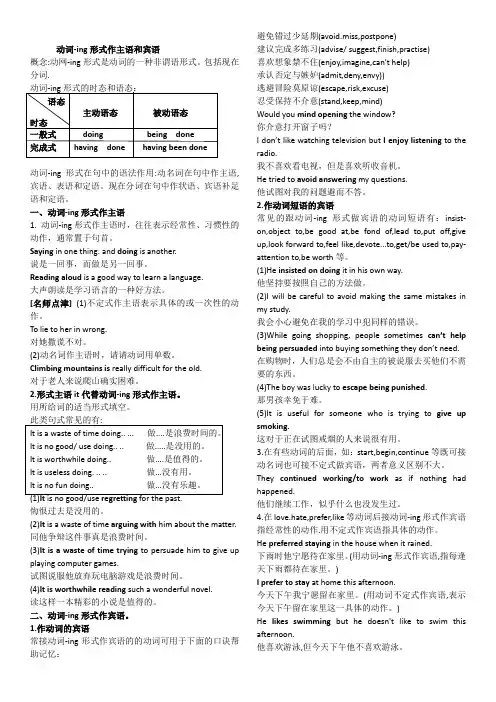
动词-ing形式作主语和宾语概念:动网-ing形式是动词的一种非谓语形式。
包括现在分词.动词-ing形式的时态和语态:语态主动语态被动语态时态一般式doing being done完成式having done having been done动词-ing形式在句中的语法作用:动名词在句中作主语,宾语、表语和定语。
现在分词在句中作状语、宾语补足语和定语。
一、动词-ing形式作主语1. 动词-ing形式作主语时,往往表示经常性、习惯性的动作,通常置于句首。
Saying in one thing. and doing is another.说是一回事,而做是另一回事。
Reading aloud is a good way to learn a language.大声朗读是学习语言的一种好方法。
[名师点津](1)不定式作主语表示具体的或一次性的动作。
To lie to her in wrong.对她撒谎不对。
(2)动名词作主语时,请请动词用单数。
Climbing mountains is really difficult for the old.对于老人来说爬山确实困难。
2.形式主语it代替动词-ing形式作主语。
用所给词的适当形式填空。
此类句式常见的有:It is a waste of time doing.. ... 做....是浪费时间的。
It is no good/ use doing.. .. 做.....是没用的。
It is worthwhile doing.. 做....是值得的。
It is useless doing. .. .. 做...没有用。
It is no fun doing.. 做...没有乐趣。
悔恨过去是没用的。
(2)It is a waste of time arguing with him about the matter.同他争辩这件事真是浪费时间。
(3)It is a waste of time trying to persuade him to give up playing computer games.试图说服他放弃玩电脑游戏是浪费时间。
![新人教必修4 Unit2 Working the land-Grammar[ing形式]](https://uimg.taocdn.com/5a0cf5e383d049649b665886.webp)
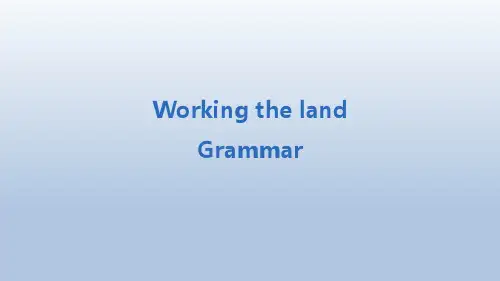
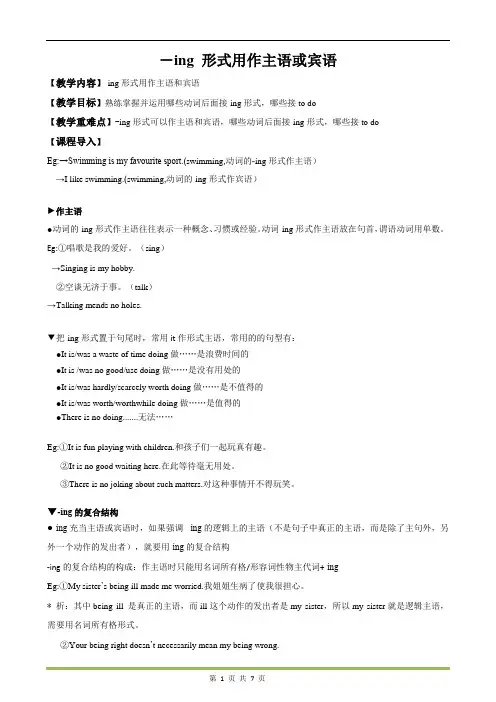
-ing 形式用作主语或宾语【教学内容】-ing形式用作主语和宾语【教学目标】熟练掌握并运用哪些动词后面接-ing形式,哪些接to do【教学重难点】-ing形式可以作主语和宾语,哪些动词后面接-ing形式,哪些接to do【课程导入】Eg:→Swimming is my favourite sport.(swimming,动词的-ing形式作主语)→I like swimming.(swimming,动词的-ing形式作宾语)►作主语●动词的-ing形式作主语往往表示一种概念、习惯或经验。
动词-ing形式作主语放在句首,谓语动词用单数。
Eg:①唱歌是我的爱好。
(sing)→Singing is my hobby.②空谈无济于事。
(talk)→Talking mends no holes.▼把-ing形式置于句尾时,常用it作形式主语,常用的的句型有:●It is/was a waste of time doing做……是浪费时间的●It is /was no good/use doing做……是没有用处的●It is/was hardly/scarcely worth doing做……是不值得的●It is/was worth/worthwhile doing做……是值得的●There is no doing.......无法……Eg:①It is fun playing with children.和孩子们一起玩真有趣。
②It is no good waiting here.在此等待毫无用处。
③There is no joking about such matters.对这种事情开不得玩笑。
▼-ing的复合结构●-ing充当主语或宾语时,如果强调-ing的逻辑上的主语(不是句子中真正的主语,而是除了主句外,另外一个动作的发出者),就要用-ing的复合结构-ing的复合结构的构成:作主语时只能用名词所有格/形容词性物主代词+-ingEg:①My sister’s being ill made me worried.我姐姐生病了使我很担心。
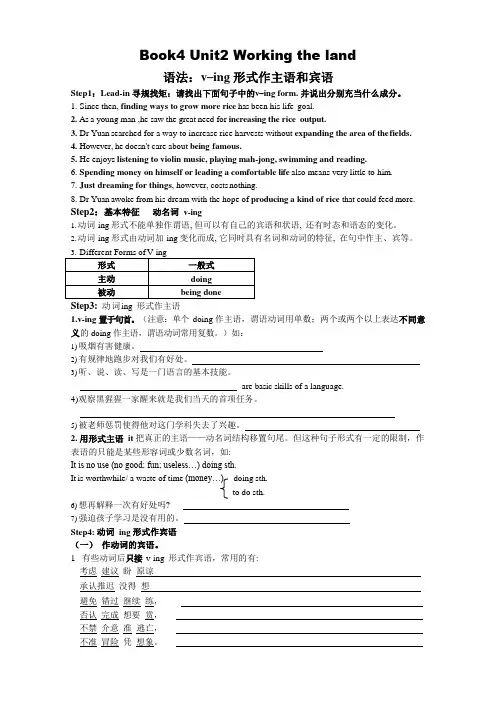
Book4 Unit2 Working the land语法:v–ing 形式作主语和宾语Step1:Lead-in 寻规找矩:请找出下面句子中的v–ing form. 并说出分别充当什么成分。
1.Since then, finding ways to grow more rice has been his life goal.2.As a young man ,he saw the great need for increasing the rice output.3.Dr Yuan searched for a way to increase rice harvests without expanding the area of the f ields.4.However, he doesn't care about being famous.5.He enjoys listening to violin music, playing mah-jong, swimming and reading.6.Spending money on himself or leading a comfortable life also means very little to him.7.Just dreaming for things, however, costs nothing.8.Dr Yuan awoke from his dream with the hope of producing a kind of rice that could feed more. Step2:基本特征动名词v-ing1.动词-ing 形式不能单独作谓语, 但可以有自己的宾语和状语, 还有时态和语态的变化。
2.动词-ing 形式由动词加-ing 变化而成, 它同时具有名词和动词的特征, 在句中作主、宾等。
动词ing 形式作主语1.v-ing 置于句首。
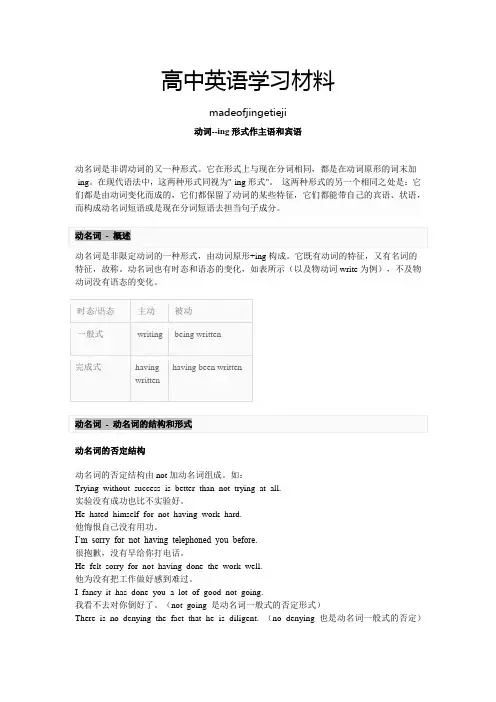
高中英语学习材料madeofjingetieji动词--ing形式作主语和宾语动名词是非谓动词的又一种形式。
它在形式上与现在分词相同,都是在动词原形的词末加-ing。
在现代语法中,这两种形式同视为"-ing形式"。
这两种形式的另一个相同之处是:它们都是由动词变化而成的,它们都保留了动词的某些特征,它们都能带自己的宾语、状语,而构成动名词短语或是现在分词短语去担当句子成分。
动名词- 概述动名词是非限定动词的一种形式,由动词原形+ing构成。
它既有动词的特征,又有名词的特征,故称。
动名词也有时态和语态的变化,如表所示(以及物动词write为例),不及物动词没有语态的变化。
时态/语态主动被动一般式 writing being writtenhaving been written完成式havingwritten动名词- 动名词的结构和形式动名词的否定结构动名词的否定结构由not加动名词组成。
如:Trying without success is better than not trying at all.实验没有成功也比不实验好。
He hated himself for not having work hard.他悔恨自己没有用功。
I’m sorry for not having telephoned you before.很抱歉,没有早给你打电话。
He felt sorry for not having done the work well.他为没有把工作做好感到难过。
I fancy it has done you a lot of good not going.我看不去对你倒好了。
(not going 是动名词一般式的否定形式)There is no denying the fact that he is diligent. (no denying 也是动名词一般式的否定)动名词复合结构通常情况下,动名词的逻辑主语为谓语动词的主语。
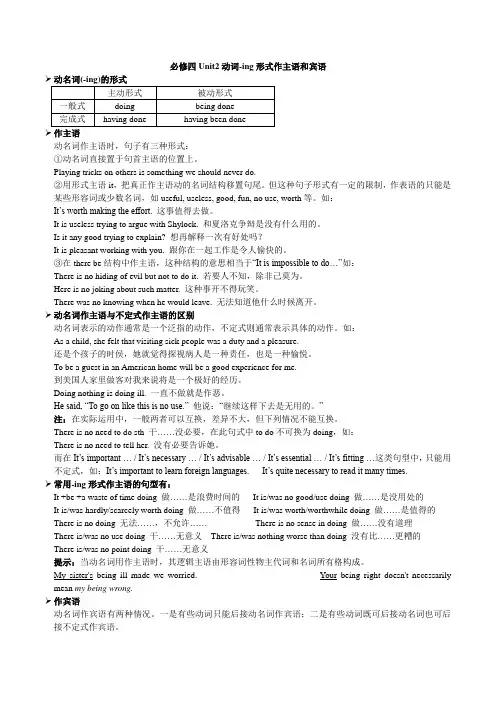
必修四Unit2动词-ing形式作主语和宾语动名词作主语时,句子有三种形式:①动名词直接置于句首主语的位置上。
Playing tricks on others is something we should never do.②用形式主语it,把真正作主语动的名词结构移置句尾。
但这种句子形式有一定的限制,作表语的只能是某些形容词或少数名词,如useful, useless, good, fun, no use, worth等。
如:It’s worth making the effort.这事值得去做。
It is useless trying to argue with Shylock. 和夏洛克争辩是没有什么用的。
Is it any good trying to explain? 想再解释一次有好处吗?It is pleasant working with you. 跟你在一起工作是令人愉快的。
③在there be结构中作主语,这种结构的意思相当于“It is impossible to do…”如:There is no hiding of evil but not to do it. 若要人不知,除非己莫为。
Here is no joking about such matter. 这种事开不得玩笑。
There was no knowing when he would leave. 无法知道他什么时候离开。
动名词作主语与不定式作主语的区别动名词表示的动作通常是一个泛指的动作,不定式则通常表示具体的动作。
如:As a child, she felt that visiting sick people was a duty and a pleasure.还是个孩子的时侯,她就觉得探视病人是一种责任,也是一种愉悦。
To be a guest in an American home will be a good experience for me.到美国人家里做客对我来说将是一个极好的经历。
【本讲教育信息】一、教学内容It is / was useless / no use / no good doing …做……是无用/无益的It is/was worth/worthwhile doing …做……是值得的It is no use crying over spilt milk. 覆水难收。
It’s worth making the effort. 这事值得去做。
It’s a waste of time arguing about it. 争辩此事是在浪费时间。
(3) 在there is no 结构中通常用动词-ing形式作主语常见的句型有:There is/was no doing…无法在……;不允许……There is/was no sense (in) doing…做……没有道理/意义There is/was no use/ point (in ) doing…干……无意义There is no joking about such matter.这种事开不得玩笑。
You don’t take advice so there is no point in asking for it.你不听劝说,因此征求别人的意见也就没有什么意义了。
注意:There is no need to do sth. 干……没必要,在此句式中to do 不可换为doing。
There is no need to tell her. 没有必要告诉她。
2.动词-ing 形式作主语与不定式作主语的区别:动词-ing 形式作主语通常表示一种抽象的动作概念,即泛指某种行为或动作;不定式作主语通常表示具体动作或具体意义。
Talking mends no holes. 空谈于事无补。
It’s an honor for me to be invited to the party.我很荣幸被邀请参加这个晚会。
3. 当动词-ing 形式用作主语时,其逻辑主语由形容词性物主代词或名词所有格构成。
必修4 Unit2 语法动词的-ing形式作主语和宾语非谓语动词分为动名词(即:v-ing)、动词不定式和分词(现在分词和过去分词)三种。
非谓语在句中不能作谓语,所以没有人称和数的变化,但有时态和语态的变化。
非谓语在句中可作主语、宾语、表语、定语、宾语补足语和状语。
本单元我们主要学习动名词作主语和宾语的用法。
一、动词的-ing形式作主语1. 动词的-ing形式作主语往往表示经常性、习惯性的动作,谓语用单数。
①Talking to him is talking to a wall. 和他说话等于对牛弹琴。
②Climbing mountains is really fun. 爬山真是有趣。
③Seeing is believing. 眼见为实④Listening to music is one of my favorite hobbies.温馨提示:动词的-ing和不定式都可以作主语,动词的-ing作主语表示经常性、习惯性的动作,不定式作主语往往表示具体的或一次性的动作,作宾语时的情况也是如此。
①To watch a football match is what I want to do today.(to do做主语表示一次性或具体的动作)②Swimming is great exercise.游泳是项很好的锻炼。
③To clean the classroom is his job today.2.常用-ing形式作主语的句型有:(1)It is/was +adj. +doing sth.It is/was worthwhile doing 做……是值得的(2) It +be +a waste of time doing 做……是浪费时间(3) It is/was+ no +n.+ doing sth.It is/was no use doing 做……没用处It is/was no good doing 做……没有好处(4) 在there be 句型中There is/was +no +doing (joking/ knowing…) 无法……,不允许……There is/was nothing worse than doing 没有比……更糟的There is/was +no +n.+ doin g→There is/was no sense in doing 做……没有道理There is/was no point doing 做……无意义e.g.①It is no use/no good crying over spilt milk. 覆水难收②It is a waste of time persuading such a person to join us.③There is nothing worse than failing in the exam.没有比考试不及格更糟糕的事情了。
Unit 2 Working the land知识点总结要点梳理1. If so句式if so如果这样if not如果不是这样if necessary.如果必要的话if any如果有的话或即使有的话if ever如果曾经有过或即使有过的话if possible如果可能的话2.struggle (vi.)& (n.)struggle with/against与……斗争struggle for努力争取……;为……而斗争struggle to one’s feet挣扎着站起来struggle to do sth.努力做某事3.hunger(n.)饥饿;欲望;渴望&(v.)(使)饥饿;渴望hungry adjbe hungry for…渴望得到……go hungry吃不饱;挨饿hunger to do sth.渴望做某事disturbing adj 令人不安的disturb v disturbed adj4. expand (vt.&vi.)使变大;伸展e xpand… into…把……扩展/发展成……5. rid… of …使……摆脱/除去……cure sb. of sth.医好某人的病be/get rid of…摆脱rid oneself of…从……解脱rob sb. of sth.抢劫某人某物warn sb. of sth.警告某人某事remind sb. of sth.提醒某人某事inform sb. of sth.通知某人某事4.be satisfied with对……满意=be pleased/content with to one’s satisfaction使某人满意的是With satisfaction满意地satisfying(adj.)令人满意的satisfaction(n.)满意;满足satisfactory(adj.)令人满意的freedom n 自由free adj 自由的v 释放freely adv6. would rather宁愿;宁可would rather(not) do sth.宁愿(不)做某事would do sth. rather than do sth.=would rather do sth. than do宁愿做某事(而)不愿做某事would rather+从句(句子需用虚拟语气)7. Therefore(adv.)因此;所以;因而用在句首,其后要有逗号Therefore, we must learn English well.用在两个分句之间,即一个句子的一部分表示原因因而另一部分表示结果时,一般其前要用分号;若第二个分句前是逗号或无符号,则要注意前加andE.g. I had a headache; therefore I could not go to your party.I was ill, and therefore could not go therefore.8.equip (vt.&vi.)配备;装备e quip…with…用……装备……be equipped with装备;配备equipment(n.) U设备;装备 a piece of equipment一件设备office equipment办公室设备export v 出口import v 进口nationality n国籍nation n 国家,民族national adj 国家的,民族的Occupation n 职业occupy v 占据9. die from死于……die of/from死于……die away逐渐消失die down逐渐转弱die off相继死去die out灭绝,消失die for为……牺牲10.in need of in( great)need of (非常)需要(后常跟名词)in need 需要in memory of为了纪念……,in praise of为了表扬……in case of如果,即使in favor of赞成in honor of为纪念/庆祝……in face of面对11. confuse(vt.)使迷惑;使为难confused adj confusing adjconfuse A with/and B把A与B混淆be confused about sth.对……感到困惑be/get confused by sth.被……搞糊涂12.regret(vt.)遗憾;惋惜&(n.)遗憾;懊悔regretful(adj.)遗憾的;后悔的regret doing sth.后悔做了某事regret to say/inform that…遗憾地说/告知……regret that从句遗憾……with great/deep regret很遗憾to one’s regret=to the regret of sb.让某人感到遗憾的是13. build up逐渐增加;建立;开发build up a fame建立名声build up one’s health/body增进健康build up one’s strength(增强体力)14.lead to导致;造成(后果);通向lead sb.to a place引导某人去某个地方lead a …life过……的生活Lead sb to do= lead to sb’s doing 导致某人做。